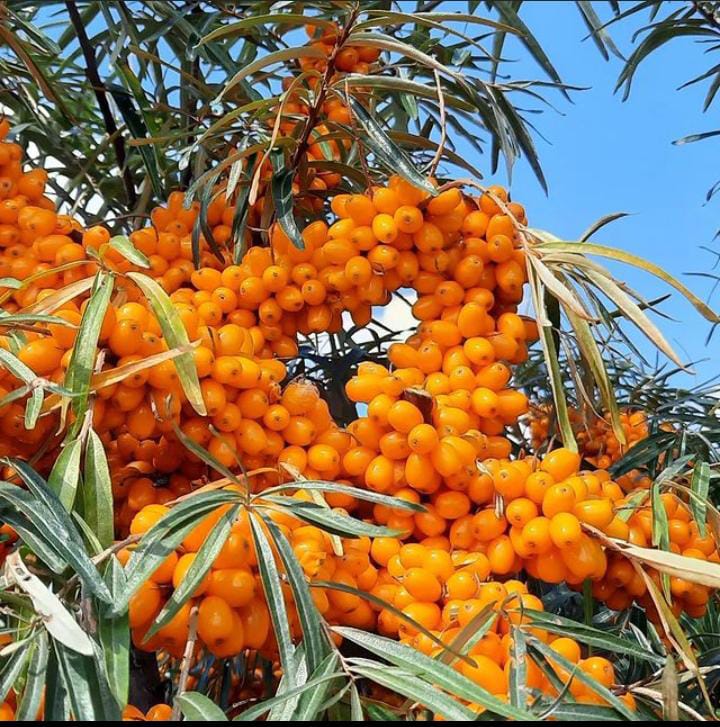Seabuckthorn (Hippophae rhamnoides) is a unique and versatile plant with a long history and a wealth of fascinating facts. This article will delve into its history, origin, cultivation, nutritional value, medicinal applications, and other interesting aspects.
Key Details about Sea Buckthorn:
Latin Name: Hippophae Rhamnoides L.
Family: Sea Buckthorn belongs to the Elaeagnaceae family, also known as the Oleaster family, which includes small trees and shrubs.
Common Names: Sea Buckthorn is also known as Sea Berry, Himalaya Berry, Sandthorn, Swallow Thorn, and Siberian Pineapple in different regions. In India (Hindi), it is locally known as Ames in Uttarakhand and Chharma in Himachal Pradesh.
The fruits of Sea Buckthorn typically mature in September.
Why is Sea Buckthorn Considered a "Superfood"?
Sea Buckthorn is often referred to as a "superfood" due to its high nutritional value and balance of over 200 nutrients compared to other foods.
One of the rarest components found in Sea Buckthorn is omega-7 fatty acid, along with omega-3, -6, and -9 fatty acids. The presence of omega-7 in Sea Buckthorn provides benefits for both skin and overall health, including improving cholesterol levels.
History:
Sea Buckthorn is one of the few plants with a long history, estimated to be around 70 million years old. In Greek mythology, it was used as fodder for horses to promote weight gain and healthy, shiny hair, hence its Latin name "Hippophae rhamnoides L.," meaning "A tree that makes horses shiny."
Sea Buckthorn has been used for centuries in Chinese medicine to treat chronic infections like colds, coughs, and to detoxify the lungs and body.
Over time, Sea Buckthorn has evolved to develop numerous compounds to survive harsh conditions, making it a valuable food source. These unique characteristics have contributed to the anecdotes and historical significance of Sea Buckthorn.
The history of seabuckthorn traces back thousands of years. It is believed to have been used in ancient Greece and Tibet for its medicinal properties. Theophrastus, an ancient Greek philosopher, mentioned a plant resembling seabuckthorn in his writings around 1211 BCE. In ancient India, the Ayurvedic texts documented the therapeutic benefits of seabuckthorn, referring to it as "Sanjivanibooti" which was used to revive Lord Rama’s younger brother, Laxman Ji. Tibetan traditional medicine also utilized seabuckthorn for various ailments. Over time, the use of seabuckthorn spread to different regions across Europe and Asia.
In the 20th century, seabuckthorn gained significant attention in Russia, leading to large-scale cultivation and research. In the 1970s, China established the Seabuckthorn Research Center to explore its potential applications. The 1980s witnessed increased interest in seabuckthorn in Europe for its nutritional and medicinal properties. Today, seabuckthorn continues to gain recognition worldwide.
Origin and Distribution:
Seabuckthorn is native to the mountainous regions of Europe and Asia. It can be found across countries such as Russia, China, Mongolia, India, and Nepal. The plant thrives in harsh and cold climates, including high altitudes and sandy soils. Its ability to withstand extreme conditions has contributed to its widespread distribution.
Cultivation:
Seabuckthorn can be cultivated through various methods such as seeds, cuttings, or layering. It requires well-drained sandy soil and thrives in full sunlight. The plant is dioecious, meaning it has separate male and female plants. Both male and female plants are necessary for fruit production. Seabuckthorn plants start bearing fruit after three to five years, with optimum yields achieved after eight to ten years of growth.
Regions in India:
In India, seabuckthorn is primarily found in the cold desert regions of Uttarakhand, Ladakh and Himachal Pradesh. The high-altitude areas of himalaya provide favorable conditions for its cultivation. The unique climate and soil characteristics of these regions contribute to the growth of high-quality seabuckthorn plants.
Benefits and Nutritional Value:
Seabuckthorn is renowned for its exceptional nutritional profile and health benefits. It is packed with essential vitamins, minerals, antioxidants, and fatty acids. Some key benefits and nutritional components of seabuckthorn include:
Vitamin C: Seabuckthorn is one of the richest sources of vitamin C, containing significantly higher levels than citrus fruits. Vitamin C boosts the immune system, aids in collagen production, and acts as an antioxidant.
Essential Fatty Acids: Seabuckthorn is abundant in essential fatty acids, including omega-3, -6, -7, and -9. These fatty acids contribute to cardiovascular health, brain function, and skin health.
Antioxidants: Seabuckthorn contains a variety of antioxidants, such as flavonoids and carotenoids, which help neutralize free radicals and protect the body against oxidative stress.
Minerals: Seabuckthorn is a good source of minerals like potassium, calcium, magnesium, and iron, which are essential for various bodily functions.
Amino Acids: It also contains a range of amino acids, including all nine essential amino acids required by the human body.
Medicinal Applications:
Seabuckthorn has been traditionally used in various systems of medicine for its therapeutic properties. Its medicinal applications include:
Immune System Support: The high vitamin C content in seabuckthorn strengthens the immune system and helps fight off infections.
Cardiovascular Health: The presence of omega-3, -6, -7, and -9 fatty acids in seabuckthorn supports heart health, helps regulate cholesterol levels, and promotes healthy blood pressure.
Skin Health and Wound Healing: Seabuckthorn oil is widely used in skincare products for its moisturizing, anti-inflammatory, and wound-healing properties. It helps nourish the skin, promote cell regeneration, and alleviate various skin conditions like eczema and acne.
Gastrointestinal Disorders: Seabuckthorn has been used in traditional medicine to alleviate symptoms of gastric ulcers, improve digestion, and reduce inflammation in the gastrointestinal tract.
Inflammation and Pain Relief: The anti-inflammatory properties of seabuckthorn have been studied for their potential in reducing inflammation and relieving pain associated with conditions like arthritis.
Eye Health: Seabuckthorn oil has shown potential in promoting eye health and reducing the risk of eye-related disorders due to its high content of vitamins, antioxidants, and fatty acids.
Primary Users:
Seabuckthorn finds applications in various industries and is utilized by different groups, including:
Food and Beverage Manufacturers: Seabuckthorn fruits are used to produce juices, jams, jellies, sauces, and other food products.
Cosmetics and Skincare Companies: Seabuckthorn oil and extracts are incorporated into skincare products such as creams, lotions, serums, and soaps due to their beneficial effects on the skin.
Herbal Medicine Practitioners and Pharmaceutical Industries: Seabuckthorn is used in traditional medicine systems like Ayurveda and traditional Chinese medicine. It is also gaining attention in modern pharmaceutical research for its potential therapeutic applications.
Livestock Farmers and Animal Feed Producers: Seabuckthorn leaves and branches serve as nutritious fodder for livestock, contributing to their health and productivity.
Production and Harvesting:
The harvesting of seabuckthorn fruits requires careful handling due to the plant's thorny nature. Various methods are employed, including handpicking, shaking the branches, and mechanical harvesting. The fruits are processed to obtain juice, oil, or other extracts, which are used in different industries.
Future Prospects:
The future of seabuckthorn appears promising, with growing interest in its medicinal, nutritional, and ecological benefits. Ongoing research explores its potential in functional foods, nutraceuticals, and pharmaceuticals. Seabuckthorn's ability to thrive in challenging environments, its versatility in application, and its valuable nutritional composition make it an attractive option for sustainable agriculture and the development of novel products.
In conclusion, seabuckthorn has a rich history, remarkable nutritional value, and numerous health benefits. Its cultivation, medicinal applications, and usage in various industries make it a plant of great importance. As research and awareness continue to grow, seabuckthorn's potential will likely be further explored, leading to new discoveries and applications for this extraordinary plant.


Sources:
https://www.verywellhealth.com/the-benefits-of-sea-buckthorn-89947



